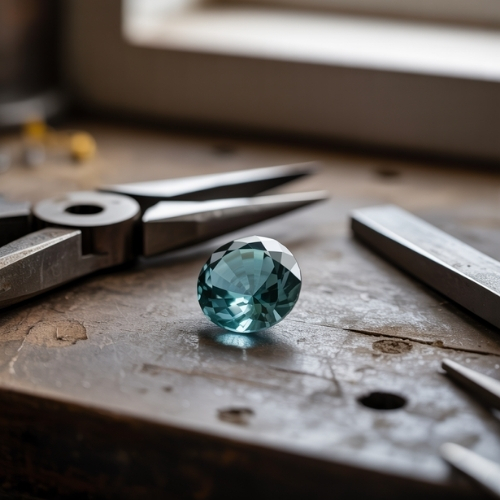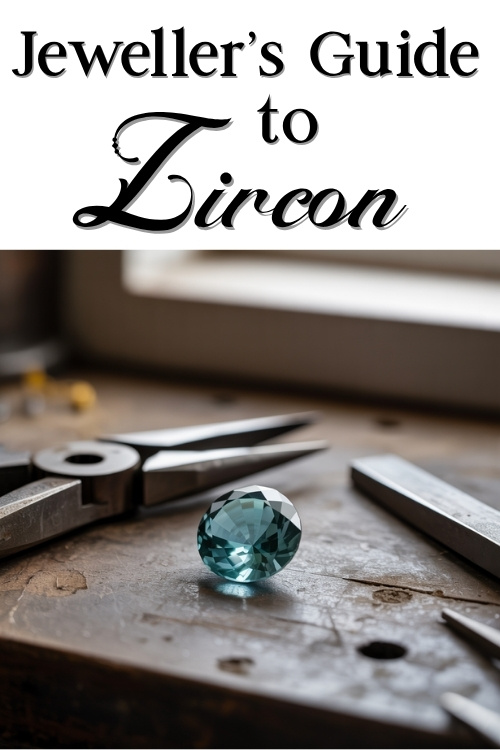Zircon is a gemstone of quiet brilliance, a natural beauty that hides ancient secrets within its sparkle. Some zircon crystals date back over four billion years, making them among the oldest known substances on Earth. Yet despite its deep history, zircon often surprises with its lively fire and striking range of colours. Whether glowing golden-orange, whispering sky blue, or shimmering clear, this gem brings both story and sparkle to the jeweller’s bench.
Basic Identification Information
Name & Synonyms:
Zircon
Species:
Zircon
Colour Range:
Blue, colourless, golden-brown, orange, red, pink, green, yellow, purple (rare)
Refractive Index:
1.780 – 2.024
Birefringence:
0.000 to 0.059
Optical Sign:
Uniaxial +
Pleochroism:
Weak and 2 colours
Blue stones: Deep sky blue and colourless to yellowish grey
Red stones: Red and clove brown
Brown stones: Reddish brown and yellowish brown
Specific Gravity:
3.90 – 4.73
Fluorescence:
Inert to moderate response to UV light.
Lustre:
Vitreous (glass-like) to adamantine (diamond-like)
Clarity (GIA Type I–II):
Type I to Type II
Usually eye-clean, though inclusions are also common which is why it sits between type I and II.
Gems Often Mistaken For Zircon:
Cubic zirconia (CZ), Diamond, Sapphire, Topaz, Spinel
Mohs Hardness:
6 to 7.5
Wearability:
Fair to Good
Birthstone:
December (alongside turquoise and tanzanite)
Spotting Synthetic (Lab-Grown) Zircon
Lab-created zircon is virtually absent from the jewellery market. However, zircon is often confused with cubic zirconia (CZ) which is a completely different, synthetic material.
Common Treatments
Most blue and colourless zircons have been heated to eliminate brown overtones and enhance clarity. This treatment is considered stable and permanent, but it may make the stone slightly more brittle.
Durability & Setting Considerations
Zircon’s structure makes it a gemstone that requires thoughtful handling, both at the bench and in wear. Despite its respectable hardness, it can be brittle and is prone to chipping, especially at facet edges or along cleavage planes.
When designing with zircon, protective settings such as bezels or halos are often the most suitable choice, particularly for rings or other pieces that may be worn frequently. Open-back settings can highlight zircon’s lively brilliance, but care should be taken to avoid placing strain on corners or thin edges.
Metal choice also contributes to the gem’s overall presentation. Cool-toned blue zircon is complemented by white metals such as silver, platinum, or white gold, while warmer shades like golden, brown, or orange zircon pair beautifully with yellow gold.
During setting and finishing, zircon should be handled gently. Use light, precise tools and avoid over-tightening claws or bezels, especially with heat-treated stones, which may be more brittle.
Sudden changes in temperature should also be avoided, as they can cause internal stress or even lead to fracturing.
Care Instructions
Cleaning
Use warm water, mild soap, and a soft brush is best practice.
Avoid ultrasonic or steam cleaning, especially for heat-treated stones.
Storage
Store zircon separately from harder gems to avoid scratching. Wrap them in soft fabric or use individual compartments.
Daily Wear
Best suited for earrings, pendants, and brooches. If used in rings or bracelets, opt for low-impact designs or those intended for occasional wear.
Market & Ethical Notes
Zircon is a naturally occurring gemstone that offers exceptional beauty at an accessible price point, particularly in smaller sizes or less well-known colours. It remains one of the more affordable natural options on the market. That said, the value of zircon rises significantly for stones with strong colour saturation, especially in the case of vivid red or highly sought-after blue varieties. These can fetch premium prices due to their rarity and visual impact.
Zircon is mined in several countries, with notable deposits found in Cambodia, Sri Lanka, Myanmar, Vietnam, and Tanzania.
At present, zircon mining is not widely associated with major ethical concerns, but for transparency and consumer confidence, it’s always advisable to inquire about sourcing and treatment history where possible.
Symbolic & Spiritual Meanings
With a history that stretches back billions of years, zircon is often seen as a stone of ancient memory and cosmic connection. It’s traditionally associated with grounding, clarity, and wisdom, making it a meaningful choice for clients interested in the spiritual or energetic properties of gemstones.
Blue zircon, in particular, is linked to the throat chakra and is believed to support truth, communication, and inner clarity. While warmer tones, such as golden and earthy brown zircon, are said to connect with the solar plexus and root chakras, encouraging confidence, stability, and a strong sense of self.
🔗 Dive deeper into Zircon’s Symbolic & Spiritual Meanings
Etymology
The word “zircon” likely stems from the Persian term zargun, meaning “gold-coloured.” Though it’s now known to come in a broad range of colours, these rich golden-brown tones remain its most traditional and historically prized form.
🔗Curious about how Zircon was viewed in ancient cultures? Explore its fascinating myths and legends (coming soon)
📌 Save this jeweller’s guide to zircon for quick reference next time you’re working with this stunning gem.


